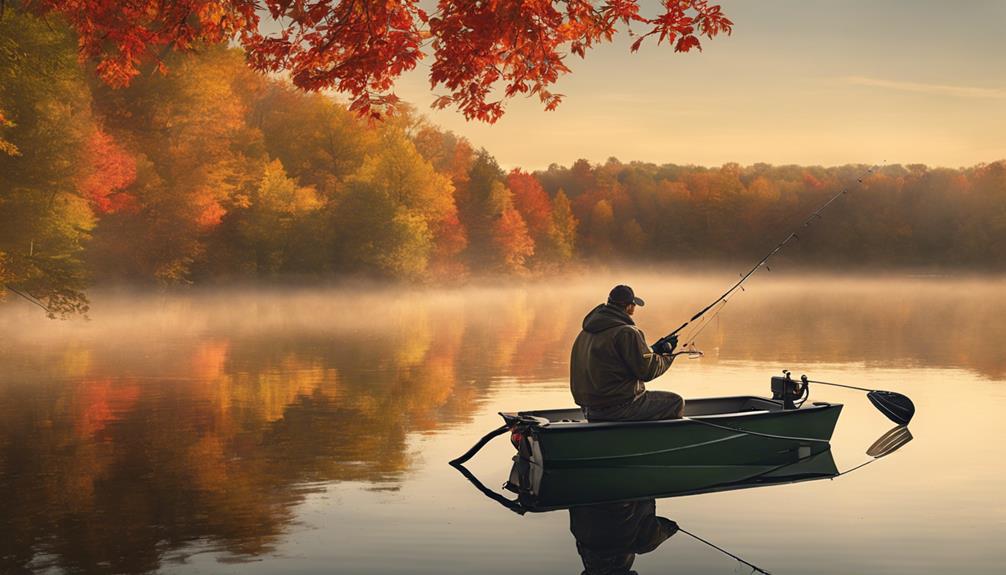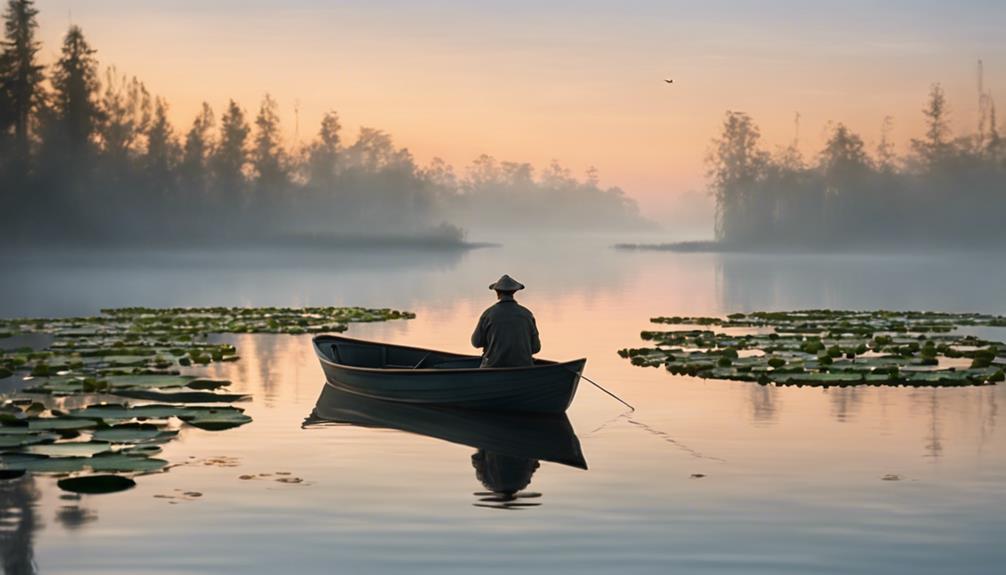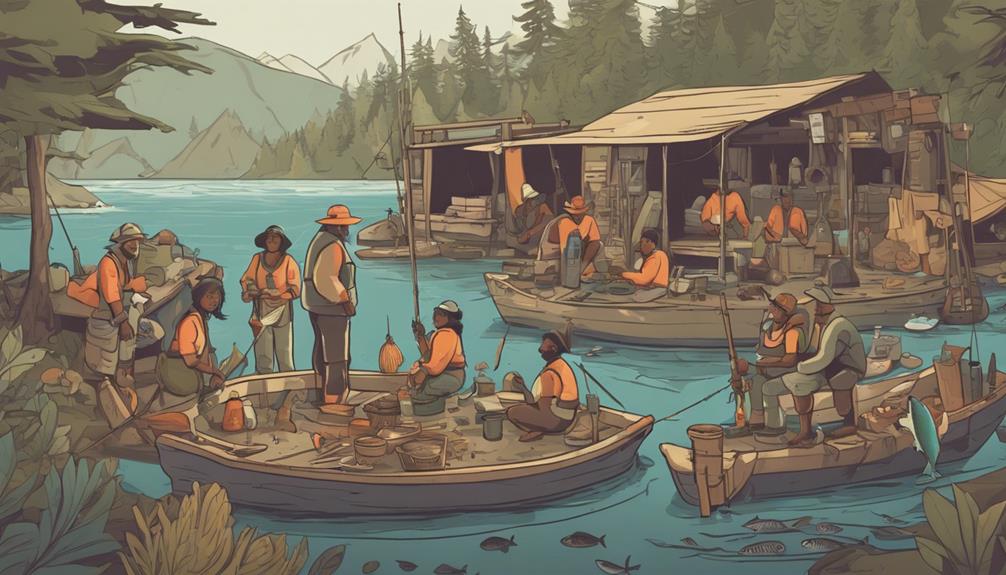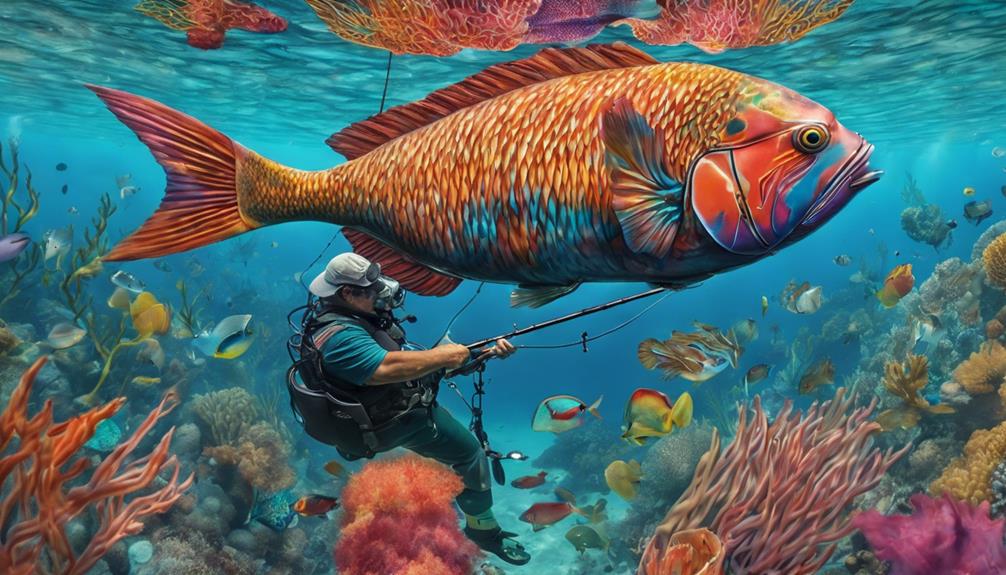You might think that crappie angling is just about luck, but there are proven methods that can increase your success. From understanding crappie behavior to choosing the right gear, there are key strategies that can make a significant difference in your fishing outings.
As you explore the nuances of crappie angling, one crucial aspect often overlooked is the art of presentation. Mastering this skill can be the game-changer that sets you apart from the casual angler.
Understanding Crappie Behavior
To catch more crappie, observe their behavior patterns carefully and adjust your angling techniques accordingly. Understanding crappie feeding habits is crucial for a successful fishing trip. Crappie are known to be opportunistic feeders, often preying on smaller fish, insects, and crustaceans. They tend to feed actively during low light conditions such as dawn and dusk, making these times ideal for fishing. When targeting crappie, consider using small jigs or live bait that mimics their natural prey to increase your chances of a bite.
Another important aspect of crappie behavior to consider is their spawning behavior. Crappie typically spawn in the spring when water temperatures reach around 55-65°F. During this time, they move to shallow waters near structures like submerged trees or brush piles to build nests. Male crappie create nests by fanning the sediment with their fins, preparing for the females to lay eggs. When crappie are spawning, they can become more aggressive and territorial, which can be advantageous for anglers. Targeting these spawning areas with techniques like casting jigs or minnows near the nests can yield great results.
Choosing the Right Gear
Selecting the appropriate gear is essential for optimizing your crappie angling success. When it comes to choosing the right gear, focusing on selecting appropriate lures and using correct equipment can significantly impact your fishing experience.
First, selecting appropriate lures is crucial for attracting crappie. Jigs are a popular choice among anglers for crappie fishing due to their versatility and effectiveness. You can opt for tube jigs, curly tail jigs, or marabou jigs in various colors to mimic the crappie's favorite prey. Additionally, soft plastic lures like grubs and minnow imitations can also be effective in enticing crappie to bite.
Secondly, using correct equipment is vital for successfully reeling in crappie. A light or ultralight spinning rod paired with a matching reel is ideal for crappie fishing. These setups provide the sensitivity needed to detect subtle bites while still offering the flexibility to handle the crappie's delicate mouth. Spool your reel with light monofilament or fluorocarbon line in the 2-6 lb test range to prevent spooking the fish in clear waters.
Mastering Crappie Rigging Techniques
When perfecting your crappie angling skills, mastering various rigging techniques is key to increasing your success on the water. Understanding depth variations and presentation techniques can significantly enhance your chances of landing more crappie.
Depth variations play a crucial role in crappie fishing. These fish often suspend at different depths depending on factors like water temperature and time of day. By mastering rigging techniques that allow you to adjust your bait's depth quickly, such as using slip bobbers or vertical jigging, you can effectively target crappie at their specific depth preferences. Experimenting with different depths until you find where the crappie are congregating can lead to more bites and a more fruitful fishing expedition.
Presentation techniques are another essential aspect of crappie rigging. Crappie can be finicky biters, so presenting your bait in a natural and enticing manner is vital. Techniques like spider rigging, where multiple rods are set up at varying depths and angles from the boat, or using live bait rigged in a way that mimics natural movement, can make a significant difference in attracting bites. Paying attention to how your bait is moving in the water and adjusting your rigging technique accordingly can help you tempt even the most cautious crappie into striking. Mastering these rigging techniques will undoubtedly improve your crappie angling success.
Identifying Prime Crappie Locations
Understanding where prime crappie locations are can significantly boost your chances of a successful fishing trip. When targeting crappie, consider factors like depth exploration and structure analysis. Crappies are known to gather around underwater structures such as fallen trees, brush piles, or submerged rocks. These areas provide cover and attract baitfish, making them ideal hunting grounds for crappie. By studying maps or using fish finders to locate these structures, you can increase your chances of finding crappie hotspots.
Additionally, water temperature plays a crucial role in crappie behavior. During different seasons, crappie will move to specific depths based on water temperature preferences. In warmer months, they may be found in deeper waters, while in cooler months, they tend to move closer to the surface. Understanding these temperature patterns can guide you to the right spots for crappie fishing.
Weather patterns also influence crappie movements. Before heading out, check the weather forecast. Crappie are sensitive to changes in weather, and their feeding habits can be affected by factors such as sunlight, wind, and pressure systems. Fishing during stable weather conditions can improve your chances of success. By combining depth exploration, structure analysis, monitoring water temperature, and considering weather patterns, you can effectively identify prime crappie locations for a rewarding angling experience.
Perfecting Crappie Jigging Skills
To improve your crappie angling success, mastering the art of jigging is essential. Jigging is a technique that involves moving the lure in a way that mimics the movement of prey, enticing the crappie to strike.
Here are some advanced tips and expert advice to help you perfect your crappie jigging skills:
- Vary Your Jigging Techniques: Experiment with different jigging motions such as twitching, hopping, and dragging to see what triggers more bites from crappie.
- Adjust Jigging Depth: Crappie can be found at various depths depending on the time of day and water conditions. Be ready to adjust your jigging depth accordingly.
- Use Lighter Jigs in Clear Water: In clear water conditions, opt for lighter-colored jigs with subtle movements to entice crappie without scaring them off.
- Try Vertical Jigging: When crappie are suspended in deeper water, vertical jigging directly below your boat can be highly effective.
- Match Lure Size to Crappie Preferences: Pay attention to the size of baitfish in the area and choose crappie lures that closely resemble them in size and color for better results.
Utilizing Live Bait Strategies
Incorporate live bait effectively to increase your chances of attracting crappie during your fishing expeditions. Live bait offers several advantages when targeting crappie. It provides a realistic and natural presentation that can be more appealing to these fish compared to artificial lures. One effective technique is to use live minnows, which are a favorite of crappie. When using live bait, ensure it's lively and fresh to entice the fish.
Bait presentation plays a crucial role in enticing crappie. One tip is to adjust the depth of your bait based on where the crappie are located. If they're suspended at a particular depth, make sure your bait is at the same level. Experiment with different depths until you find where the crappie are biting. Additionally, using a bobber can help keep your bait at the desired depth and indicate when a fish is nibbling.
To enhance your live bait strategy, try using slip bobbers for a more sensitive bite indication. These bobbers allow your bait to move more freely, resulting in a more natural presentation. Remember to keep your bait lively and pay attention to any movements on the surface to increase your chances of a successful crappie catch.
Crappie Fishing in Different Seasons

How do the changing seasons affect crappie fishing success rates? Crappie fishing can vary significantly depending on the season. Understanding these seasonal patterns can greatly improve your chances of a successful fishing trip.
Seasonal Tips for Crappie Fishing:
- Winter Crappie: During the winter months, crappie tend to move to deeper waters. Look for them near underwater structures such as brush piles or submerged trees. Slow down your presentation as crappie are less active in the colder water.
- Spring Fishing: As the water temperature warms up in spring, crappie become more active. They move to shallower waters to spawn. Focus on areas with vegetation, docks, or rocky structures. Use brightly colored jigs or live minnows to attract their attention.
- Summer Patterns: In the summer, crappie can be found in a variety of depths depending on the time of day. Early morning and late evening are good times to target shallow waters. During the day, look for them in deeper areas near structures or drop-offs.
- Fall Feeding: Crappie feed heavily in the fall to prepare for the winter months. Look for them in schools around submerged vegetation or near creek channels. Use small jigs or minnows to entice bites.
- Adapt to Changing Conditions: Always be prepared to adjust your techniques based on the current weather and water conditions. Crappie behavior can change quickly, so stay flexible in your approach.
Safely Releasing Caught Crappie
Changing seasons can impact crappie fishing success rates, and once you've caught a crappie, ensuring its safe release is crucial for conservation efforts. Proper handling of caught crappie is essential for their survival post-release. When practicing catch and release, sustainability should be the angler's priority to maintain healthy crappie populations in the long run.
To safely release caught crappie, follow these steps. Firstly, avoid using stainless steel hooks as they can cause significant damage to the fish. Instead, opt for barbless hooks that are easier to remove and cause less harm. Secondly, handle the crappie with wet hands or a wet cloth to protect its slimy coating, which is vital for its health. Avoid touching the fish excessively as it can strip away this protective layer. Thirdly, if the fish is deeply hooked and removing the hook would cause harm, cut the line as close to the hook as possible. The crappie can still survive with the hook in place, and it will eventually dissolve. Lastly, release the crappie gently back into the water, ensuring it has fully recovered before swimming away.
Frequently Asked Questions
How Can I Effectively Target Crappie During the Spawning Season?
To effectively target crappie during the spawning season, focus on understanding their behavior and the water temperature. Use techniques like jigging or casting near shallow waters where crappie tend to spawn.
Develop a strategy that involves patience and finesse to lure them in. By observing their patterns and adjusting your approach accordingly, you can increase your chances of a successful crappie angling experience during the spawning season.
What Are Some Common Mistakes Anglers Make When Jigging for Crappie?
When jigging for crappie, common mistakes anglers make include using improper technique, wrong timing, inadequate equipment, and choosing the wrong location.
To avoid these errors, ensure you're using the proper jigging technique, timing your movements correctly, having the right equipment, and fishing in ideal locations where crappie are known to gather.
Are There Any Specific Colors or Sizes of Jigs That Work Best for Catching Crappie?
When selecting jigs for crappie, consider colors like chartreuse, pink, and white, as they tend to attract these fish. Opt for smaller jigs, around 1/32 to 1/16 ounce, for better results.
Vary the fishing depth until you find where the crappie are hanging out. Experiment with different jigging techniques, such as slow retrieves or subtle twitches, to entice more bites.
What Is the Best Way to Locate Schools of Crappie in a Large Body of Water?
To find schools of crappie in a large water body, consider using depth finders and underwater cameras. These tools can help you locate underwater structures where crappie might gather.
Once you've identified potential spots, try using live bait or artificial lures to attract the fish. Experiment with different depths and techniques until you find what works best for enticing crappie to bite.
Good luck on your angling adventure!
How Can I Adjust My Fishing Techniques When Targeting Crappie in Deep Water Versus Shallow Water?
When fishing for crappie in deep water versus shallow water, you'll need to adjust your techniques. Consider using trolling techniques for deep water and focusing on understanding crappie behavior.
In shallow water, try varying your depth and experimenting with different live bait options. By adapting your approach based on the water depth and the behavior of the crappie, you can increase your chances of a successful catch.
Conclusion
Now that you have learned about effective methods for crappie angling, it's time to put your knowledge to the test on the water.
Remember to observe crappie behavior, use the right gear, and master rigging techniques.
Identify prime locations, perfect jigging skills, and utilize live bait strategies.
Adjust your tactics for different seasons and always practice safe catch and release methods.
Get out there and enjoy the thrill of catching crappie!



